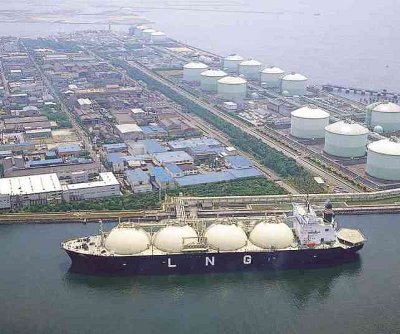India’s state-owned Petronet, the country’s largest importer of liquefied natural gas, is looking into purchasing a 25 percent share of a future LNG terminal to be situated in Gujarat.
That terminal, to be developed by the Gujarat State Petroleum Corporation, is expected to have a capacity of 5 million tonnes. The split is projected to be 50 percent to GSPC, 25 percent to the Adani Group, and the other 25 percent to Petronet.
 Petronet’s reported profits remained relatively stable, though domestic terminal production is clearly on the decline. The Dahej terminal, located in Gujarat, produced 122 trillion British thermal units compared to the previous quarter’s 135 trillion BTUs. This is partly the result of India’s GAIL India Ltd. and GSPC importing lower volumes of gas thanks to worldwide prices rising fast. Currently, prices hover around $18-$19 per million BTUs.
Petronet’s reported profits remained relatively stable, though domestic terminal production is clearly on the decline. The Dahej terminal, located in Gujarat, produced 122 trillion British thermal units compared to the previous quarter’s 135 trillion BTUs. This is partly the result of India’s GAIL India Ltd. and GSPC importing lower volumes of gas thanks to worldwide prices rising fast. Currently, prices hover around $18-$19 per million BTUs.
Petronet is looking to expand its natural gas resources (hence eyeing the future terminal in Gujarat). As well, the company has just completed a 5 million-ton LNG import terminal located in Kochi, which is set to come online around July. It will continue to operate at around 12 percent capacity due to lacking pipeline infrastructure.
Over 2013-2014, that terminal is expected to import between four and five shiploads of LNG. GAIL, meanwhile, is working on a pipeline that’d connect the Kochi terminal to the major cities of Mangalore, Chennai, and Bangalore. That’s expected in the next fiscal year, and the terminal will accordingly boost operations to 75 percent capacity.
Finally, the Dahej terminal is also projected to be expanded to 15 million tons capacity. Contracts for this expansion are in the works, due by September.
LNG Abroad
Meanwhile, as domestic gas production declines, Petronet is looking abroad. The Wall Street Journal reports that the company has reached a preliminary agreement with United LNG LP of the U.S. The deal provides for Petronet to buy 4 million metric tons of LNG per year for the next two decades. The details are to be finalized by 2014, with supply beginning around 2017 onward.
And two years ago, GAIL entered into a 20-year agreement with Cheniere Energy (NYSE: LNG) for 3.5 million tons of LNG imports per year. That gas is expected to be routed through the Louisiana-based Sabine Pass facility, which Cheniere operates.
This is rapidly becoming a pattern, as Indian gas importers rush to try and fulfill exploding domestic demand. Currently, India produces around 75 percent of all domestic natural gas demand, but—due largely to declining domestic reserves—the nation will quickly need to secure a wider network of import agreements in order to keep up with demand.
Already, some gas-fired power plants have had to shut down or switch over to coal due to inadequate supplies.
Our analysts have traveled the world over, dedicated to finding the best and most profitable investments in the global energy markets. All you have to do to join our Energy and Capital investment community is sign up for the daily newsletter below.
Burgeoning Asian Demand
India isn’t alone in experiencing skyrocketing domestic demand for natural gas. Other nations across Asia—like Japan, whose closed nuclear plants have left an energy deficit—are hungry for gas as well.
Meanwhile, the North American shale revolution means the U.S. currently has vast reserves of natural gas—far more than it can use. Indeed, we’re flaring off excess gas for lack of transportation infrastructure.
Localized supply shortages over in Asia mean gas prices there are far higher than they are in the U.S. For example, compared to the average price of $4 per million British thermal unit here, Japan pays roughly $18. Japan is also the world’s biggest importer of liquefied natural gas.
However, the import/export situation is a double-edged sword. U.S. companies are pushing for government approval to develop export terminals in order to profit off Asian demand for LNG. But that very move—while profitable in the short run—will inevitably lead to domestic price increases in the longer run. That’s causing a lot of political debate over the question at present.
Of course, as far as the U.S. and India are concerned, such energy agreements will likely strengthen an already fairly solid international relationship. According to Petronet, United LNG will route the gas via the Main Pass hub situated offshore near Louisiana.
Expanded LNG export relationships with India would lead to an increase in U.S. jobs and add a revenue stream for the foreseeable future in the U.S., while India would benefit from the new found supply of energy and be able to move away from its reliance on the Middle East.
If you liked this article, you may also enjoy:


